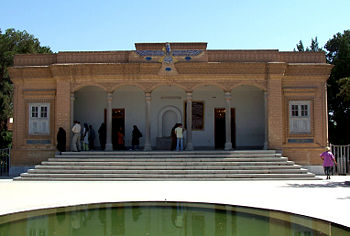Zoroastrianism: Difference between revisions
imported>Minhaj Ahmed Khan Lodi (minor changes) |
imported>Minhaj Ahmed Khan Lodi No edit summary |
||
| Line 1: | Line 1: | ||
{{subpages}} | {{subpages}} | ||
[[Image:Faravahar.svg|right|thumb|350px|{{#ifexist:Template:Faravahar.svg/credit|{{Faravahar.svg/credit}}<br/>|}}The Faravahar, best-known symbol of the Zoroastrian faith]] | |||
'''Zoroastrianism''' is the religion and philosophy based on the teachings ascribed to the prophet [[Zoroaster]] (Zarathustra, Zartosht). '''Mazdaism''' is the religion with recognises [[Ahura Mazda]]'s supreme authority being the one God. | '''Zoroastrianism''' is the religion and philosophy based on the teachings ascribed to the prophet [[Zoroaster]] (Zarathustra, Zartosht). '''Mazdaism''' is the religion with recognises [[Ahura Mazda]]'s supreme authority being the one God. | ||
Revision as of 02:14, 18 March 2008
Zoroastrianism is the religion and philosophy based on the teachings ascribed to the prophet Zoroaster (Zarathustra, Zartosht). Mazdaism is the religion with recognises Ahura Mazda's supreme authority being the one God.
History
The religion was founded by Zarathushtra (Zoroaster in Greek; Zarthosht in India and Persia). Conservative Zoroastrians assign a date of 6000 BCE to the founding of the religion; other followers estimate 600 BCE. Historians and religious scholars generally date his life sometime between 1500 and 1000 BCE on the basis of his style of writing. The date of birth of Zoroaster is very controversial. It is known that after Alexander's conquest of the Achemenid Empire, the Greeks imposed an "age of Alexander" calendar, which Zoroastrian priests replaced with an "age of Zoroaster" calendar. It was estimated that he was born 258 years before Alexander, hence the date of 600 BCE was accepted.[1]
Zoroaster was born in Northeast Iran or Southwest Afghanistan. He was born into a Bronze Age culture with a polytheistic religion (the worship of many gods), which included animal sacrifice and the ritual use of intoxicants. This religion was quite similar to the early forms of Hinduism of the Indus Valley. Zoroaster's birth and early life are little documented. What is known is recorded in the Gathas - the core of the Avesta, which contains hymns thought to be composed by Zoroaster himself. Born into the Spitama clan, he worked as a priest. He was a family man, with a wife, three sons and three daughters. Zoroaster rejected the religion of the Bronze Age Iranians with their many gods and oppressive class structure, in which the Karvis and Karapans (princes and priests) controlled the ordinary people. He also opposed animal sacrifices and the use of the hallucinogenic Haoma plant (possibly a species of ephedra) in rituals.[2]
When Muslim Arabs invaded Persia in 650 CE, a small number of Zoroastrians fled to India where most are concentrated today. Those who remained behind have survived centuries of persecution, systematic slaughter, forced conversion, heavy taxes, etc. They now number only about 18,000 and reside chiefly in Yazd, Kernan and Tehran in what is now Iran. The Canadian 1991 census counted 3,190 Zoroastrians in that country. The actual number is believed to be much higher. According to the Fezana Journal survey, published quarterly by the Federation of Zoroastrian Associations of North America, there are about 11,000 Zoroastrians in the United States, 6,000 in Canada, 5,000 in England, 2,700 in Australia and 2,200 in the Persian Gulf nations.[3]
Worship
The Zoroastrians have often been described as 'fire worshipers'. However, this is quite false, as Zoroastrians use fire as a purifying agent, which signifies Ahura Mazda's purity. Use of fire as a purifying agent is central to Zoroastrianism. Worship usually takes place inside a Fire Temple, five times a day (similar to Islam, some scholars signify that Zoroastrianism influenced Islamic salat, while Muslims maintain that every religion, including Zoroastrianism, was similar to Islam initially). Mordern Zoroastrians continue to maintain the fire ritually, and the fire is centrally placed in the temple. Priests cover their mouths with cloth in order to avoid contaminating the fire. Worshipers wash themselves before entering the temple, bringing offerings of sandalwood and money, in turn, they receive ashes which they rub on their faces.[4]
The inner ceremonies
The most important inner ceremony is the Yasna. The Yasna can only be performed by ritually purified priests in Iran and India. It contains 72 chapters of text and can only be performed in the morning when the sun is rising. The ceremony takes place in the inner sanctuary, the pawi, and only ritually purified priests may enter the pawi. The whole ceremony takes two hours to celebrate. The Zoroastrian priesthood is adamant that without the Yasna, the whole world would collapse, and Ahrimanic forces would be victorious.[5]
The other two important Zoroastrian ceremonies are the Vendidad and Visperad. The Vendidad is a nocturnal version of the Yasna with additional material added from books of the same name. The Visperad is a combination of the Yasna and Vendidad.[6]
Afrinagan - The outer ceremony
The Afrinagan is open to all audiences. It is suitably performed in a clean area (such as a house). In the Afrinagan, Ahura Mazda is praised for his blessings upon the world. Fruit, wine, milk, eggs, flowers, and water form part of the ritual, as well as they ever-present fire. The Afrinagan is generally performed by two priests, zot and raspi, but other qualified priests may also perform. It is appropriate to wash and dress before reciting the prayers. The Afrinagan is not restricted to Fire Temples in Iran and India.[7]
Notes
- ↑ Shahbazi, A. Shapur (1977), "The 'Traditional Date of Zoroaster' Explained", Bulletin of the School of Oriental and African Studies 40 (1): 25-35
- ↑ BBC - Religion & Ethics Zoroaster: Zoroaster's vision
- ↑ ReligiousTolerance.org Zoroastrianism
- ↑ Jefferey Brodd - World Religions: A Voyage of Discovery, page 184 ISBN 0884897257
- ↑ Peter Clark - Zoroastrianism: An Introduction to an Ancient Faith, page 99, ISBN 1898723788
- ↑ Peter Clark - Zoroastrianism: An Introduction to an Ancient Faith, page 104, ISBN 1898723788
- ↑ Peter Clark - Zoroastrianism: An Introduction to an Ancient Faith, page 104-106, ISBN 1898723788

